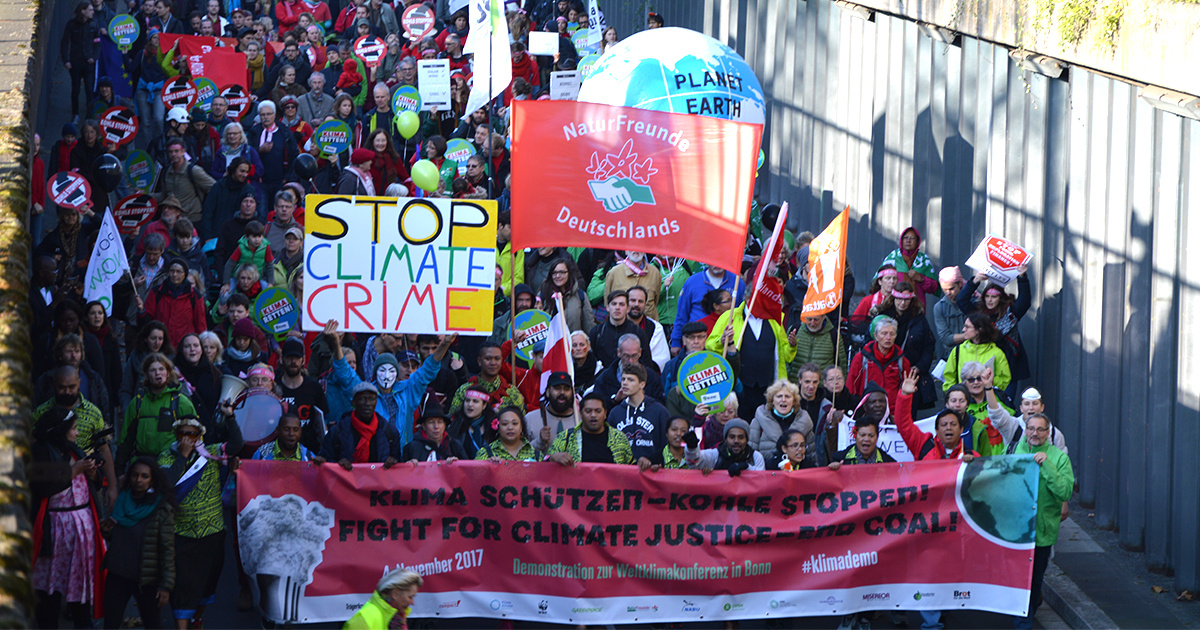

Protesters in Bonn call on politicians to fight climate change. Spielvogel / Wikimedia Commons
As the world increasingly looks to be on track for a catastrophic 3°C of global warming, world leaders and diplomats gathered in Bonn, Germany to turn the Paris agreement into a set of rules.
In that sense the 23rd Conference of the Parties (COP23), which concluded on Saturday, accomplished its goal of keeping the process alive by setting up the rules that will be finalized next year in Poland. But the conference also kicked a number of issues down the road. The round of climate talks heard repeated calls for a more ambitious approach to slashing carbon emissions but did not initiate any conclusive solutions, though it should be noted that no major decisions were expected.
Under the Paris agreement, nearly 200 nations submitted pledges to slow their greenhouse-gas emissions to keep the planet well below 2°C.
“Climate change is an issue determining our destiny as mankind,” German Chancellor Angela Merkel said before acknowledging that Germany was likely to miss its emissions goals due to its continued reliance on coal. Germany isn’t the only country tied up in coal. Just last Monday scientists noted that greenhouse gases are likely going to rise again, in part due to the rebound of coal in China.
But coal’s persistence also took a hit—more than 20 countries led by the UK and Canada launched the Powering Past Coal Alliance. Each country involved pledged to end its use of coal by 2030, while the UK pledged to cease burning coal by 2025. It should be noted that coal use has been declining in all of these countries. The U.S., for its part, promoted “clean coal” at the only side event it hosted at the summit.
Despite playing the role of obstructionist in the coal arena, observers noted that overall, the U.S. withdrawal from the Paris agreement had little effect on the proceeding of negotiations. The U.S. didn’t block anything, insiders stated, and remained neutral, while China and India didn’t use the vacuum left by the U.S. to gain advantage. Outside the spotlight, a team of career state department negotiators pressured China, India and other developing countries to practice transparency in verifying their emissions reductions. At the same time, U.S. negotiators helped reject proposals from poor countries seeking an increase in climate aid from rich countries.
Unofficially, the U.S. presence was felt as a U.S. delegation sidestepped the Trump administration’s obstinance on climate change. Democratic senators, governors and mayors joined the conference. “We’re here because it’s in our national security interests to deal with climate change,” New York’s Mayor Michael Bloomberg said.
That cities and states are picking up the mantle left behind by Trump’s withdrawal from the Paris agreement is not insignificant. Many U.S. states and even cities are larger than some European states, while urban centers are the primary producers of carbon emissions. “There is an impression by politicians here that President Trump in person is no longer the voice of the free Western world,” Christian Ehler, a German lawmaker who heads the European Parliament’s delegation for relations with the U.S., said to the Washington Post. “We are much more carefully looking now to the diversity of what is being discussed in the United States, and we see that California is one of the powerhouses of the world economically.”
By the conclusion of COP23, very few countries announced any new initiatives to cut emissions. A hoped-for announcement from China on a cap-and-trade program was delayed and Germany announced that it would hold “tough discussions” on coal in the future.
Though many environmentalists said Bonn was a step in the right direction, major issues remain to be solved. Current pledges keep the world on track for 3°C of warming, if not more. And the road to making the necessary changes to stay below 2°C seems increasingly difficult to reach. To remain below the Paris agreement’s 2°C, nearly all coal plants will need to be taken out of commission or fitted with carbon technology. The transportation sector would need to transition to largely electric-powered vehicles. World carbon emissions would likely have to peak in the next few years and then fall by half every decade all the way down to zero by midcentury. It remains to be seen whether enough political will can be drummed up for such a transition.

 233k
233k  41k
41k  Subscribe
Subscribe 